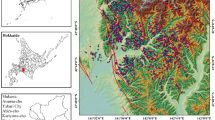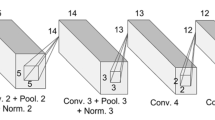Abstract
To ensure the proper adoption of new technologies in identifying the potential geologic hazard on tourist routes, convolutional neural network (CNN) is applied in the radar image geologic hazard information extraction. A scientific and practical geologic hazard radar identification model is built based on identification of CNN image and calculation of big data algorithm, which can effectively improve the geologic hazard identification accuracy. Through experiments, the geologic hazard radar image data are verified, and the practicality of radar image intelligent identification under CNN and big data is also verified. The results show that the images of different resolution sizes all play a significant role in identification of geologic hazard performed by CNN. However, there are differences in the performance of different CNN models. With the continuous increase in training samples, the identification accuracy of various network models is also improved. Through radar image test, the identification capability of CNN model is the best, the highest precision is 93.61%, and the geologic hazard recall rate is 98.27%. Apriori algorithm is proposed for data processing, and the running speed and efficiency of identification models are improved, with favorable identification effect in variable data sets. To sum up, this research can provide theoretical ideas and practical value for the development of potential geologic hazard identification on tourist routes.










Similar content being viewed by others
References
Akter S, Wamba SF (2019) Big data and disaster management: a systematic review and agenda for future research. Ann Oper Res 283(1):939–959
Amerta IMS (2017) The role of tourism stakeholders at Jasri tourism village development, Karangasem regency. Int J Soc Sci Human 1(2):20–28
Bai E, Guo W, Tan Y (2019) Negative externalities of high-intensity mining and disaster prevention technology in China. Bull Eng Geol Env 78(7):5219–5235
Becken S, Khazai B (2017) Resilience, tourism and disasters. Butler RW (ed) Tourism and Resilience.CAB International: Boston, pp 96–102.
Bui DT, Tsangaratos P, Nguyen VT et al (2020) Comparing the prediction performance of a deep learning neural Network model with conventional machine learning models in landslide susceptibility assessment. CATENA 188:104426–104431
Can R, Kocaman S, Gokceoglu C (2019) A convolutional neural network architecture for auto-detection of landslide photographs to assess citizen science and volunteered geographic information data quality. ISPRS Int J Geo Inf 8(7):300–308
Chang P, Grinband J, Weinberg B, Bardis M, Khy M, Cadena G, Su M-Y, Cha S, Filippi C, Bota D (2018) Deep-learning convolutional neural networks accurately classify genetic mutations in gliomas. Am J Neuroradiol 39(7):1201–1207
Chen G P, Zhao J S, Yuan L, Ke Z J, Gu M, Wang T (2017) Implementation of a geological disaster monitoring and early warning system based on multi-source spatial data: a case study of deqin county, Yunnan Province. Nat Haz Earth Syst Sci Discuss, pp 1–15
Chen M, Liu Q, Huang S, Dang C (2020b) Environmental cost control system of manufacturing enterprises using artificial intelligence based on value chain of circular economy. Enterprise Inf Syst.
Chen Y, Hu S, Mao H et al (2020a) Application of the best evacuation model of deep learning in the design of public structures. Image vis Comput 102:103975–103986
Deng S, Li W (2020) Spatial case revision in case-based reasoning for risk assessment of geological disasters. Geomat Nat Haz Risk 11(1):1052–1074
El-Sawy A, Hazem E B, Loey M (2016In) CNN for handwritten arabic digits recognition based on LeNet-5. In: International conference on advanced intelligent systems and informatics. Springer, Berlin, pp 566−575
Essa FA, Abd Elaziz M, Elsheikh AH (2020) An enhanced productivity prediction model of active solar still using artificial neural network and Harris Hawks optimizer. Appl Therm Eng 170:115020–115026
Fan R, Wang L, Yan J et al (2020) Deep learning-based named entity recognition and knowledge graph construction for geological hazards. ISPRS Int J Geo Inf 9(1):15–21
Fleming K, Abad J, Booth L, Schueller L, Baills A, Scolobig A, Petrovic B, Zuccaro G, Leone MF (2020) The use of serious games in engaging stakeholders for disaster risk reduction, management and climate change adaption information elicitation. Int J Disast Risk Reduc 49:101669–101676
Gao X, Cai J (2017) Optimization analysis of urban function regional planning based on big data and GIS technology. Tech Bull 55(11):344–351
Guo WY, Tan YL, Zhao TB, Liu XM, Gu QH, Hu SC (2016) Compression creep characteristics and creep model establishment of gangue. Geotech Geol Eng 34(4):1193–1198
He F, Liu H, Liu C, et al (2021) Analysis of radar technology identification model for potential geologic hazard based on convolutional neural network and big data, pp 124–131
Heidari AA, Mirjalili S, Faris H et al (2019) Harris hawks optimization: algorithm and applications. Futur Gener Comput Syst 97:849–872
Horita FEA, de Albuquerque JP, Marchezini V et al (2017) Bridging the gap between decision-making and emerging big data sources: an application of a model-based framework to disaster management in Brazil. Decis Support Syst 97:12–22
Ke H, Chen D, Li X, Tang Y, Shah T, Ranjan R (2018) Towards brain big data classification: epileptic EEG identification with a lightweight VGGNet on global MIC. IEEE Access 6:14722–14733
Khan RU, Zhang X, Kumar R (2019) Analysis of ResNet and GoogleNet models for malware detection. J Comput Virol Hack Tech 15(1):29–37
Khan A, Gupta S, Gupta SK (2020) Multi-hazard disaster studies: Monitoring, detection, recovery, and management, based on emerging technologies and optimal techniques. Int J Disast Risk Reduc, pp 101642–101653
Jiang W, Rao P, Cao R, Tang Z, Chen K (2017) Comparative evaluation of geological disaster susceptibility using multi-regression methods and spatial accuracy validation. J Geog Sci 27(4):439–462
Li S, Wu J, Xu Z, Li L (2017) Unascertained measure model of water and mud inrush risk evaluation in karst tunnels and its engineering application. KSCE J Civ Eng 21(4):1170–1182
Liu Y, Wu L (2016) Geological disaster recognition on optical remote sensing images using deep learning. Procedia Comput Sci 91:566–575
Liu B, Zhang Y, He D, Li Y (2018) Identification of apple leaf diseases based on deep convolutional neural networks. Symmetry 10(1):11–18
Lu S, Lu Z, Zhang YD (2019) Pathological brain detection based on AlexNet and transfer learning. J Comput Sci 30:41–47
Luna JM, Padillo F, Pechenizkiy M et al (2017) Apriori versions based on mapreduce for mining frequent patterns on big data. IEEE Trans Cyber 48(10):2851–2865
Ngo PTT, Panahi M, Khosravi K et al (2021) Evaluation of deep learning algorithms for national scale landslide susceptibility mapping of Iran. Geosci Front 12(2):505–519
Pavlova I, Makarigakis A, Depret T et al (2017) Global overview of the geological hazard exposure and disaster risk awareness at world heritage sites. J Cult Herit 28:151–157
Qin L, Feng S, Zhu H (2018) Research on the technological architectural design of geological hazard monitoring and rescue-after-disaster system based on cloud computing and Internet of things. Int J Syst Assur Eng Manage 9(3):684–695
Sang X, Xue L, Ran X et al (2020) Intelligent High-Resolution Geological Mapping Based on SLIC-CNN. ISPRS Int J Geo Inf 9(2):99–103
Sameen MI, Pradhan B, Lee S (2020) Application of convolutional neural networks featuring Bayesian optimization for landslide susceptibility assessment. CATENA 186:104249–104253
Shen C, Lin H, Fan X, Chu Y, Yang Z, Wang J, Zhang S (2019a) Biomedical event trigger detection with convolutional highway neural network and extreme learning machine. Appl Soft Comput 84:105661–105669
Shen C-W, Min C, Wang C-C (2019b) Analyzing the trend of O2O commerce by bilingual text mining on social media. Comput Hum Behav 101:474–483. https://doi.org/10.1016/j.chb.2018.09.031
Singh S, Garg R, Mishra P (2018) Performance optimization of mapreduce-based apriori algorithm on Hadoop cluster. Comput Electr Eng 67:348–364
Targ S, Almeida D, Lyman K (2016). Resnet in resnet: generalizing residual architectures. arXiv preprint: arXiv:160308029, pp 1–7.
Ullo SL, Mohan A, Sebastianelli A et al (2021) A New Mask R-CNN-Based Method for Improved Landslide Detection. IEEE J Selected Top Appl Earth Observ Remote Sens 14:3799–3810
Wang P, Zhang H, Patel VM (2017) SAR image despeckling using a convolutional neural network. IEEE Signal Process Lett 24(12):1763–1767
Wang J, Wang L, Xu J et al (2021) Information needs mining of COVID-19 in chinese online health communities. Big Data Res 24:100193–100201
Wilhelm B, Ballesteros Cánovas JA, Macdonald N et al (2019) Interpreting historical, botanical, and geological evidence to aid preparations for future floods. Wiley Interdiscip Rev Water 6(1):e1318–e1321
Wu Y, Lin Y, Zhou Z, et al (2018) Seismic-net: a deep densely connected neural network to detect seismic events. arXiv preprint: arXiv:1802.02241, pp 1124–1132
Wu C, Li X, Chen W, Li X (2020) A review of geological applications of high-spatial-resolution remote sensing data. J Circuits Syst Comput 29(06):2030006–2030012
Xiao L, Zhang Y, Peng G (2018) Landslide susceptibility assessment using integrated deep learning algorithm along the China–Nepal highway. Sensors 18(12):4436–4441
Xu X, Peng S, Yang F (2018) Development of a ground penetrating radar system for large-depth disaster detection in coal mine. J Appl Geophys 158:41–47
Xu Y, Qiu X, Yang X, Lu X, Chen G (2020) Disaster risk management models for rural relocation communities of mountainous southwestern China under the stress of geological disasters. Int J Disast Risk Reduction, pp 101697–101676
Yan X, Chen M, Chen M-Y (2019) Coupling and coordination development of australian energy, economy, and ecological environment systems from 2007 to 2016. Sustainability 11:6568
Yousri D, Allam D, Eteiba MB (2020) Optimal photovoltaic array reconfiguration for alleviating the partial shading influence based on a modified harris hawks optimizer. Energy Convers Manage 206:112470–112475
Zhang Y, Wang G, Li M et al (2018) Automated classification analysis of geological structures based on images data and deep learning model. Appl Sci 8(12):2493–2501
Zhou Y, Wang H, Xu F, Jin YQ (2016) Polarimetric SAR image classification using deep convolutional neural networks. IEEE Geosci Remote Sens Lett 13(12):1935–1939
Zhu K, Xu P, Cao C et al (2021) Preliminary identification of geological hazards from songpinggou to feihong in mao county along the minjiang river using SBAS-InSAR technique integrated multiple spatial analysis methods. Sustainability 13(3):1017–1022
Zin TA, Lwin KK, Sekimoto Y (2018) Estimation of originating-destination trips in Yangon by using big data source. J Disaster Res 13(1):6–13
Acknowledgements
1. This work was supported by Supported by SiChuan key research and development plan “geological hazard identification technologies of mountain tourist line based on big data”(No. 2020YFS0354). 2. This work was supported by Supported by Scientific Research Fund Project of Yunnan Provincial Department of Education “Earthquake relief asymmetric information game dynamics model in complicated landforms” (No. 2020J0381).
Author information
Authors and Affiliations
Contributions
All authors listed have made a substantial, direct and intellectual contribution to the work, and approved it for publication.
Corresponding author
Ethics declarations
Conflict of interest
All authors declare that they have no conflict of interest.
Ethical approval
This article does not contain any studies with human participants or animals performed by any of the authors.
Informed consent
Informed consent was obtained from all individual participants included in the study.
Additional information
Communicated by Mu-Yen Chen.
Publisher's Note
Springer Nature remains neutral with regard to jurisdictional claims in published maps and institutional affiliations.
Rights and permissions
About this article
Cite this article
He, F., Liu, H., Liu, C. et al. Analysis of radar technology identification model for potential geologic hazard based on convolutional neural network and Harris Hawks optimization algorithm. Soft Comput 27, 3493–3507 (2023). https://doi.org/10.1007/s00500-021-06206-1
Accepted:
Published:
Issue Date:
DOI: https://doi.org/10.1007/s00500-021-06206-1




